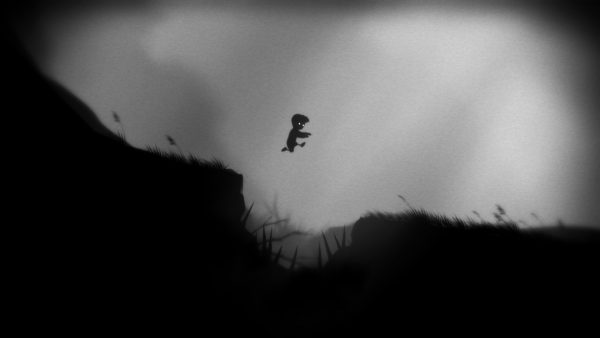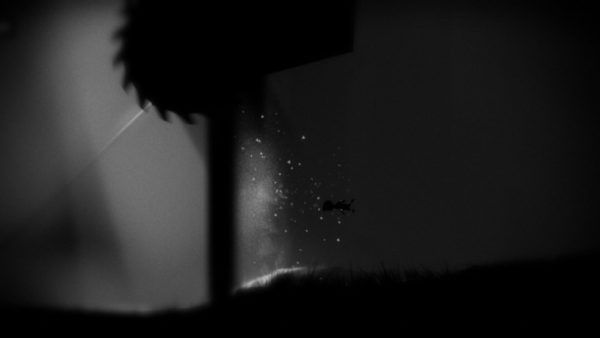
Opened World: Sharp Objects
Miguel Penabella treads through dangerous grounds.
When Limbo first released in 2010, it did so during a formative period of critiquing games as art and thinking critically about the medium beyond simply product reviews that focused on performance and technical capability. Conversations around games as art found itself in full swing during the turn of the decade—catapulted especially by contemporaneous games released on Xbox Live Arcade like Braid and Super Meat Boy—and various reviews referenced such ideas floating in critical discourse. Now over a decade since Limbo’s initial debut, that period represents a time capsule of how we understood and wrote about games. Some addressed Limbo by subverting the expectations of the game review format itself, turning instead to short lyrical descriptions rather than talking about game mechanics altogether, such as Kirk Hamilton’s short review for Paste. A deluge of exceptional articles from the now defunct Nightmare Mode—a bastion of independent games criticism from that era—stretch Limbo in different directions, such as Patricia Hernandez’s etymological breakdown of travel, Tom Auxier’s frustrations about the state of games writing in the wake of “games as art” discourse, and Eric Swain’s back-and-forth with other game essayists on the extent to which meaning can be parsed from a work that resists easy interpretation.
Such questions of Limbo and its meaning—its deeper themes and narrative goals—somewhat escapes much of the early conversations save for the few linked above. Articles commonly position Limbo within the larger aesthetic framework of film noir and German Expressionism, as in Kris Lorischild’s likening of Limbo to the silent films of F. W. Murnau, even suggesting that studio Playdead’s “expressionist inheritance” derives from his film The Last Laugh. These expressionist influences play a key role in Limbo, particularly in the stylized use of hostile environments and shadowy lighting that ground the psychological elements of the game, serving as a pretense for the physical manifestation of loss and trauma.

Opening on the image of a silhouetted boy with glowing eyes rousing from slumber in a dark, foreboding forest ripped from Grimms’ Fairy Tales, Limbo instantly establishes its heavily stylized, expressionistic world cloaked in chiaroscuro shadows. Devoid of any spoken dialogue with a soundtrack instead largely comprising low, humming ambient drones and diegetic sounds of wildlife or footsteps, the game recalls the experience of a silent film. Limbo’s aesthetic indebtedness to German Expressionism surfaces in its black-and-white presentation and even a faint flickering of light at the edges of the frame as though lit by candlelight or film projector. The stylistic hallmarks of German Expressionism, perhaps best exemplified in the bizarre, angular set designs of The Cabinet of Dr. Caligari or in the monstrous shadows of Murnau’s Nosferatu, often deployed such bold artistic direction to compensate for limited budgets. Unable to produce costly realistic settings, filmmakers instead opted for more surrealistic environments and unnatural worlds that channel heightened, chaotic emotions. Characters’ interior states of anxiety or distress are externalized onto a heavily stylized surrounding environment, and the effectiveness with which German Expressionist filmmakers were able to accomplish these ideas may explain its continuing influence on contemporary filmmakers like Tim Burton or Guillermo del Toro, and in Limbo here.
Lacking a tutorial, spoken dialogue, or any kind of straightforward set of instructions on how to play the game and the context for its story, Limbo instead relies on visuals and its spare gameplay to communicate ideas to players. One of the key ideas the game conveys is danger, specifically in its use of sharp objects like bear traps, spike pits, spider legs, and rotting pines that offer plentiful opportunities to impale, dismember, slice, and decapitate the protagonist. These sharp objects recall the kinds of nonverbal messaging in the field of nuclear semiotics, or the field of study concerning how to communicate the danger of nuclear waste repositories to a distant future after the disappearance of human civilization. To scare away would-be trespassers, researchers for Sandia National Laboratories have proposed supposedly intuitive signs that signify danger, including “menacing earthworks” of a giant spike field or a landscape of thorns, and even a sign bearing the face of Edvard Munch’s iconic expressionist painting The Scream. Serving as a defense mechanism, the idea is that the more difficult and imposing the environment, the more likely it will deter the curious from venturing into the radioactive hazards within.

Similarly, the foreboding spaces of Limbo communicate to players that this is a world of violence, without any space for reprieve, softness, and comfort. Even the sounds underscore a sense of pervasive dread, including the hollow wind, the lumbering stride of a spider, or the crash of boulders. Players will inevitably encounter game over screens upon a first playthrough simply to understand the rules of the game and its arcane puzzles through trial and error, as plentiful dangers like whirring saws, lethal turrets, and even parasitic worms festoon the landscape. Oftentimes, it’s not visually apparent that something ahead is designed to kill the protagonist, and determining safe passage will often require the brutal dismemberment of the protagonist to test the true nature of an unknown threat before trying again. Death is a constant. Like the nuclear deterrents, everything in Limbo prevents players from easily progressing forward, as though trying to safeguard deeper understanding of the world in which we inhabit.
So, what does Limbo ultimately mean? What is the game about? Lacking character dialogue or narration, its one-word title serves as one possible anchor for meaning like the title of an abstract artwork, gesturing towards some means for interpretation. Andrew Kauz offers an essay that touches on the common reading of purgatorial limbo and the satisfying ambiguity of the game, and while there’s no shortage of interpretations of Limbo, I think it’s best to speak generally about the themes. Sketching in broad strokes, Limbo explores ideas of death and the multitude of ways the environment externalizes some kind of inner trauma. While the game resists providing clear narrative contexts, it does depict the young protagonist encountering a young female figure, presumably his sister, but is unable to reach her. This encounter drives the purgatorial task of navigating through the hostile environment and the inevitable sacrifices many times over as players fail to clear obstacles. Like the Hansel and Gretel fairytale, the boy and girl are drawn into the woods only to discover violence and no easy way home. And if we are to read Limbo through the lens of its expressionist forebears, I’d suggest that the game’s treacherous environments represent an externalization of the protagonist’s internal trauma, and that the various traps and dangers serve as some psychological defense mechanism preventing us from reaching clarity. The numerous puzzles of the game are so inscrutable and deadly because they serve as mental walls to shield oneself from some traumatic realization.

In this sense, Limbo recalls the film Carnival of Souls, which (spoiler alert!) ends with the plot twist that the protagonist has been wandering in a limbo state towards the ultimate realization that she died in a tragic accident at the start of the film. Its horror visuals represent external, physical manifestations of that protagonist’s traumatized, interior psychosis that she represses throughout the film. I read the various obstacles and traps in Limbo in a similar way, as externalizations of trauma responses that keep the protagonist in a psychological limbo, unable to uncover the deeper reasons for their circumstances. Various other human figures even resemble the boy, albeit as spectral figures lacking the light of his glowing white eyes. Faceless and blank, these non-player characters casually observe and even cause death, hurling flaming tires and triggering boobytrapped apparatuses at the player to impede progress. Their macabre presence serves as a kind of memento mori, a reminder of death, and plants suspicion in the minds of players who must wonder—given the evocative title of the game and the resemblance of these interlopers to the protagonist—whether the main character himself is dead. Reminders of death are everywhere, as though calling out to the player of the reality of things: grotesque treehouse displays where corpses hang from branches, and suicidal characters that hurl themselves into waters to drown themselves, their bloated corpses serving as lily pads to traverse deep waters.
The emotional climax of Limbo further reinforces the idea that repressed trauma has been embedded onto the surrounding landscape. Over the course of the game, the forest gives way to urban spaces and industrial terrors, including inscrutable devices that reverse gravity or magnetize objects onto surfaces. The final puzzle makes use of all these topsy-turvy devices, causing the player to catapult upwards and downwards before being slingshot forward to avoid sawblades, only to slam through a glass window in a violent crash. These few seconds are a moment that the game emphasizes with slow motion camerawork, wresting control from the player in this short cutscene, the first since the opening of the game. The protagonist crashes through glass and tumbles into the ground. It is a sublime death rendered profound via slow motion, the staged drama contrasting the brutal death screens that present death matter-of-factly and as coincidental. Here, Limbo underscores the simple fact that an accident has happened: a boy was thrown into the air and knocked into the earth. Maybe it has happened before, in some other life, and the game simply needed to return us to this pivotal moment of trauma. Only by shattering through that glass can the final barrier be broken.
Miguel Penabella is a PhD student investigating slow media and game spaces. He is an editor and columnist for Haywire Magazine. His writing has been featured in Kill Screen, Playboy, Waypoint, and Unwinnable, and he blogs on Invalid Memory.